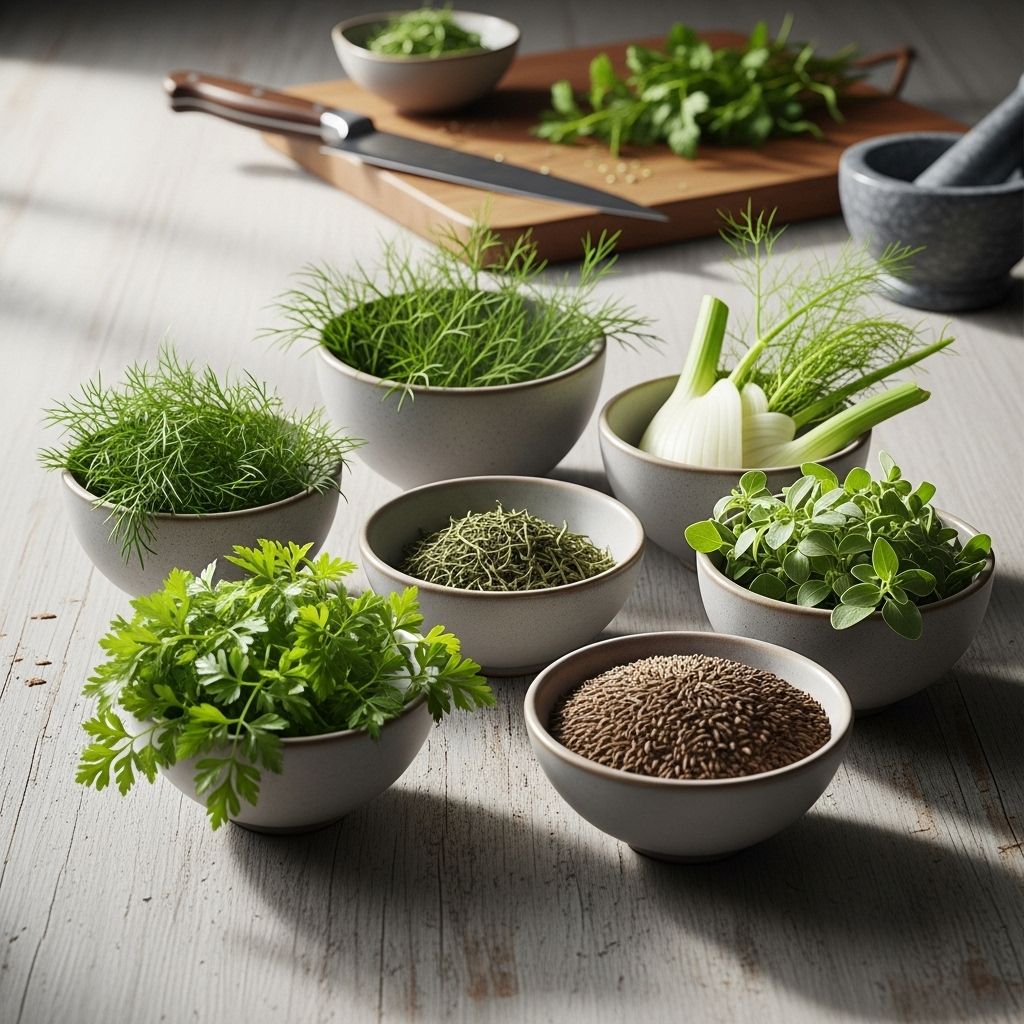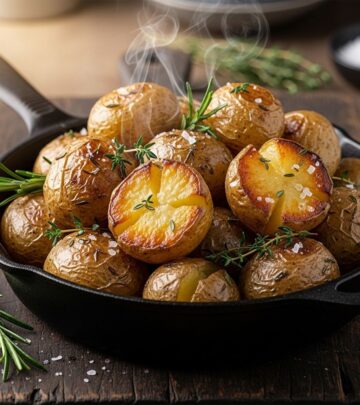Best Tarragon Substitute: 6 Versatile Kitchen Alternatives
Explore the top six alternatives to tarragon and discover the best ways to swap this unique herb in any recipe.

Image: HearthJunction Design Team
The 6 Best Tarragon Substitutes for Cooking
Tarragon’s signature blend of bittersweet, peppery, and anise-like flavors makes it a staple in classic French cuisine and many cherished recipes. Yet, tarragon isn’t always the easiest herb to find, and its unique taste can be hard to replicate directly. Whether you’re out of tarragon or just seeking a new flavor profile for your dishes, there are excellent substitutes to consider—both fresh and dried. This guide explores the best tarragon alternatives, their ideal culinary uses, flavor notes, and substitution ratios, ensuring delicious results in your cooking.
Contents
- Fresh Tarragon vs. Dried Tarragon
- The Top 6 Tarragon Substitutes
- Substitution Ratios & Tips
- Frequently Asked Questions
Fresh Tarragon vs. Dried Tarragon
Before diving into substitutes, it’s important to distinguish between fresh and dried tarragon. Fresh tarragon delivers a nuanced balance of sweet, licorice-like notes with subtle bitterness and herbal depth, making it ideal for delicate sauces, vinaigrettes, and finishing touches. Dried tarragon, on the other hand, has a more concentrated flavor—often sharper and less floral—with a slight bitterness due to the drying process. For this reason, dried tarragon is best suited for heartier dishes or recipes that allow time for the flavors to mellow and infuse.
When substituting, always consider whether your recipe calls for fresh or dried, as this will impact both flavor intensity and the choice of substitute.
The Top 6 Substitutes for Tarragon
There’s no single herb that can completely mimic tarragon, but several come close, especially when it comes to replicating its anise, sweet, or herbal notes. Here are the best options to use in place of tarragon, along with their recommended culinary applications and flavor notes.
1. Dried Tarragon (for Fresh Tarragon)
If you have dried tarragon on hand, it’s the most straightforward substitute for fresh tarragon. While the flavor is more concentrated and less delicate, dried tarragon still brings similar anise and herbal notes to your dish. Use half as much dried tarragon as you would fresh, as dried herbs are more potent.
- Best for: Sauces, stews, marinades, or recipes where tarragon is simmered.
- Flavor profile: More intense, slightly bitter, with a pronounced anise undertone.
2. Fennel Fronds
The feathery green fronds from fennel bulbs offer a fresh, sweet anise flavor remarkably similar to that of tarragon. Fennel fronds provide both the licorice note and the visual appeal, making them a top choice for salads, garnish, and fish dishes.
- Best for: Salads, seafood, garnish, and cold sauces.
- Flavor profile: Fresh, sweet, light anise/licorice taste.
3. Basil (Fresh or Dried)
Fresh basil, especially the anise-flavored Thai basil, shares some of tarragon’s licorice notes, along with a slightly peppery, sweet profile. While not identical, basil works well in many recipes that call for tarragon, particularly in Mediterranean and Italian cuisine. Dried basil is less aromatic, but still suitable in a pinch.
- Best for: Chicken, pasta, salad dressings, and sauces.
- Flavor profile: Sweet, herbaceous; some varieties with light licorice notes.
4. Dill (Fresh or Dried)
Although dill is more grassy and less sweet than tarragon, it does have a faint licorice flavor and a bright, herbal finish. Dill works especially well as a tarragon replacement in fish, egg dishes, and creamy sauces. Use either fresh or dried dill, depending on the recipe’s requirements.
- Best for: Fish, eggs, creamy dips, salad dressings.
- Flavor profile: Light, grassy, with a mild anise-like finish.
5. Marjoram or Oregano (Dried)
Marjoram brings a sweet, earthy, and slightly citrusy note, making it a good substitute for dried tarragon in heartier or more robust dishes. Oregano, closely related to marjoram, is more assertive and peppery, but also provides a warm, herby background that mimics some of tarragon’s depth. Both are best used as dried herb substitutes for dried tarragon.
- Best for: Poultry, vegetable stews, pasta sauces, salad dressings.
- Flavor profile: Marjoram is sweet, citrusy, and mild; oregano is bold and peppery.
6. Anise Seed, Fennel Seed, or Star Anise (Whole or Ground)
These pantry spices have a bold licorice flavor that closely resembles the anise component of tarragon. Use them sparingly—just a pinch is enough, as they can easily overpower a dish. Anise or fennel seeds work best in soups, broths, and slow-simmered sauces. Star anise adds a more intense flavor and should be used only in recipes where a strong anise punch is welcome.
- Best for: Soups, broths, stews, braises.
- Flavor profile: Strong, sweet, warm licorice note.
| Substitute | Form | Flavor Profile | Best Uses |
|---|---|---|---|
| Dried Tarragon | Dried | Intense, anise, slightly bitter | Sauces, stews, marinades |
| Fennel Fronds | Fresh | Fresh, sweet, light anise | Salads, seafood, garnish |
| Basil | Fresh or dried | Sweet, herbaceous, light licorice | Chicken, pasta, dressings |
| Dill | Fresh or dried | Grassy, mild anise | Fish, eggs, creamy sauces |
| Marjoram/Oregano | Dried | Earthy, citrusy, peppery | Poultry, stews, sauces |
| Anise/Fennel/Star Anise | Whole/ground seeds or pods | Strong licorice, sweet, warm | Soups, broths, braises |
Substitution Ratios & Tips for Using Tarragon Alternatives
The key to successful herb substitution is understanding both the strength and flavor profile of the alternative. Here are some general guidelines:
- Dried for Fresh: Use half the amount of dried herb as you would fresh (e.g., 1 tablespoon fresh tarragon = 1/2 tablespoon dried tarragon).
- Fresh for Fresh: Most fresh herbs (basil, fennel fronds, dill) can be used in a 1:1 ratio for fresh tarragon.
- Spices (anise, fennel seed): Start with just a pinch per tablespoon of tarragon called for, and add more to taste.
- Marjoram/Oregano: As dried herbs, use in equal amounts for dried tarragon; adjust based on taste preference.
Pro Tips for Herb Substitution Success
- Taste as you go, especially when using potent substitutes like anise or fennel seed.
- Consider the overall flavor of your dish—some recipes may benefit from a blend of substitutes (such as a mix of basil, dill, and marjoram).
- Fresh herbs can brighten a dish at the end of cooking, whereas dried herbs are best added earlier to allow flavors to develop.
- Try combining small quantities of similar herbs (e.g., basil and fennel fronds), to more closely approximate tarragon’s complexity.
Frequently Asked Questions (FAQs)
What is the best substitute for fresh tarragon in Béarnaise sauce?
Fennel fronds or a combination of fresh basil and dill are excellent choices. Both will mimic the sweet, anise-like flavors that tarragon imparts. For an even closer match, add a tiny pinch of anise seed.
Can I use thyme in place of tarragon?
Thyme offers an earthy, slightly citrusy flavor but lacks the distinctive anise notes of tarragon. It works well in savory dishes like chicken and vegetable recipes but won’t replicate tarragon’s unique taste in sauces where its flavor is central.
Are there any no-anise-flavor alternatives for tarragon?
For those who dislike anise or licorice flavors, marjoram, oregano, or basil are suitable alternatives. They bring herbal complexity without the licorice note.
Is it okay to skip tarragon altogether?
It depends on the recipe. If tarragon is a minor ingredient, you can often replace it with another green herb or skip it for a milder flavor. In classic sauces like Béarnaise, however, a substitute is recommended for balance.
What’s the best substitute for tarragon in French cuisine?
Fennel fronds are the top choice, followed by fresh basil and dill, as French recipes often depend on tarragon’s unique, nuanced notes.
How do I store tarragon and its substitutes?
- Store fresh herbs (tarragon, basil, dill, fennel fronds) loosely wrapped in a damp paper towel in the crisper drawer.
- Dried herbs and spices (tarragon, marjoram, oregano, anise seed) should be kept in airtight containers away from light and heat.
Quick Tips for Cooking Without Tarragon
- Layer flavors: Consider blending two or more substitutes (e.g., basil and dill) to get closer to tarragon’s unique taste.
- Taste as you cook: Add substitutes gradually and taste frequently to achieve the desired flavor profile.
- Switch up the cuisine: Use substitutes that align with your dish’s regional flavors for a harmonious outcome (e.g., basil for Italian, dill for Mediterranean).
Summary Table of Tarragon Substitutes
| Substitute | Best Used For | Flavor Notes | Substitute Ratio |
|---|---|---|---|
| Dried Tarragon | Sauces, marinades, stews | Intense, anise | 1/2 as much as fresh |
| Fennel Fronds | Garnish, salad, seafood | Sweet, fresh, licorice | 1:1 |
| Fresh Basil | Chicken, pasta, dressings | Sweet, herbaceous | 1:1 |
| Dill | Eggs, fish, creamy sauces | Grassy, mild anise | 1:1 |
| Marjoram/Oregano | Poultry, stews, pasta | Earthy, citrusy/peppery | 1:1 (dried for dried) |
| Anise/Fennel/Star Anise | Soups, stews | Strong licorice | Pinch per tablespoon |
Conclusion
While nothing can fully replicate the unique character of tarragon, these six substitutes let you keep cooking delicious meals even if you’re out of this classic French herb. Whether you lean towards the fresh brightness of fennel fronds or basil, or reach for the pantry staples like dried marjoram or anise seed, you have a variety of choices to suit your recipe and palate. Get creative, mix and match, and, most importantly, taste as you go—the key to successful herb substitution and flavorful results!
References
- https://www.allrecipes.com/tarragon-substitutes-8374330
- https://cookingandcussing.com/best-substitutes-for-fresh-tarragon/
- https://www.yummymummykitchen.com/2021/09/tarragon-substitute.html
- https://forums.welltrainedmind.com/topic/192788-what-common-herb-could-i-substitute-for-tarragon-still-make-bearnaise-sauce/
- https://www.acouplecooks.com/tarragon-substitute/
Read full bio of Shinta












